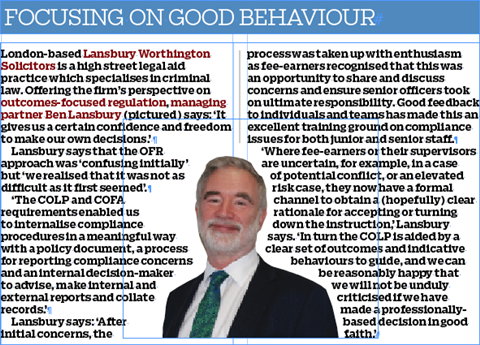Solicitors face another shake-up in the way they are regulated. The Solicitors Regulation Authority wants further liberalisation and is promising a simpler regime that will return responsibilities to individual lawyers.
The reforms are in part aimed at tackling shortcomings in the rules introduced by the SRA in 2011. At the time, the regulator had sought to shift from ‘a more prescriptive and reactive approach to regulation to a more proactive, risk-based outcomes-focused approach (OFR)’. The emphasis was placed on entities rather than individual solicitors, to allow the SRA to regulate a greater range of legal services providers (including alternative business structures) introduced through the Legal Services Act 2007. Welcoming OFR in October 2011, Legal Services Board chief executive Chris Kenny said that it would ‘promote ethical behaviour and innovation by placing responsibility for achieving regulatory outcomes squarely on the shoulders [of] legal services providers and giving them the freedom to achieve them in different ways’.
Four years later, the SRA reviewed its regulatory approach again, concluding that a key objective of the 2011 reforms had not been met. With a 30-page code of conduct and 400 pages of rules, the ‘Handbook is long, complex, onerous and costly to apply’; while the rules are ‘detailed and prescriptive’ and ‘need constant updating’. Another wholesale revision of the rules was set in train.
The ‘new model’ for regulating legal services, set out in November 2015 (in the Looking to the Future position paper), is based on ‘a targeted and proportionate regulatory approach, which is fit for purpose in our fast changing and dynamic sector’, the regulator said. It proposed two separate, shorter and simplified codes of conduct, one for solicitors and another for firms, and easier-to-follow accounts rules.
‘We want to move away from complex rules and unnecessary bureaucracy – bureaucracy that costs money and needs continuous updating. Our focus has to be on high professional standards set independently in the public interest. That can only be good for the profession and for the public,’ SRA chief executive Paul Philip said. ‘Our proposals for a shorter, sharper and clearer Handbook will free up law firms and individual solicitors to get on with the business of delivering quality legal services, while making sure there is absolute clarity about public protection.’
The SRA also wants to open up the market further by removing restrictions on where solicitors can practise. This proposal faces stiff opposition from the Law Society and many solicitors. As Kingsley Napley partner and regulatory specialist Iain Miller observes: ‘A new type of solicitor, or non-authorised entity, is going to start competing with solicitors on a slightly different regulatory basis, and it might have an impact on the market.’
Convoluted Handbook
The current Handbook has enjoyed distinctly mixed reviews. For Paul Bennett, a partner in the professional practice and employment teams at Aaron & Partners, it has been a ‘spectacular failure’. In his view, ‘it is so long and convoluted that it is difficult for both practitioners and the regulator themselves to follow and apply in practice’.
The 2011 code sets out ‘outcomes-focused conduct requirements’ which are supposed to allow solicitors the freedom to decide ‘how best to achieve the right outcomes’ for their clients. Together with the 10 mandatory principles, the code forms part of the Handbook that also includes the accounts rules. The outcomes are mandatory and by achieving them solicitors will comply with the principles. But because the outcomes can be arrived at in various ways, the SRA has provided a list of non-mandatory indicative behaviours. The code is divided into five sections, each of which is split into chapters that deal with particular regulatory issues, such as client care and conflicts of interest, and show how the principles apply in certain contexts through outcomes and indicative behaviours.

Such complexity, Bennett suggests, ‘leads to a situation whereby a regulator bringing a case will [formulate] numerous allegations, some of which will be a technical breach, and some of which will be a substantive breach, and it is difficult to distinguish which one is which’. What he describes as a ‘spectacularly small’ number of disciplinary cases each year can be explained by such a jumble of allegations failing to cohere into clear, suitable charge sheets. In 2016, the Solicitors Disciplinary Tribunal received a total of 132 new applications, a decrease of 6% from the year before. This compares with a high of 273 in the year to 10 April 2010.
OFR was intended to give regulated firms more freedom by taking compliance away from a box-ticking exercise, but Ronnie Fox, a consultant at Fox & Partners, says: ‘Outcomes-focused regulation means that you have got to make up your own mind and, if it goes wrong, it is your fault. There are more and more issues where solicitors in practice find it quite difficult to get helpful guidance from the Handbook.’ One example is dealing with conflicts of interest.
‘I would like the guidance given both in the Handbook and when you call [the SRA] to be less, “well you have got to make up your own mind” and more “this is the line we take”, because this simplifies life for practising solicitors,’ Fox says.
‘The intention was to allow flexibility and innovation,’ but the shift from a system of ‘hard and fast rules to one of complete flexibility’ has instead created ‘uncertainty’, and ‘increased the cost of regulation for many firms’, says Linda Lee, former Law Society president and a consultant at RadcliffesLeBrasseur.
OFR has not delivered much innovation either, it seems. The structure of the rulebook and in particular the ‘confusing’ indicative behaviours are ‘a barrier to automation and the use of artificial intelligence It is not a complete barrier but it is a substantive barrier,’ Bennett says.
Meanwhile, guidance on principles and outcomes has proliferated. Since its publication in 2011, the Handbook has been updated every six months and is currently at version 19.
Lee, also former chair of the Law Society’s regulatory affairs board, says: ‘Guidance has been published on all sorts of things [where] I don’t think most firms are aware it even exists.’ She adds: ‘Recently, the SRA has been putting out warning notices of the guidance that not all firms are aware is there, but what they could be in breach of.
‘The SRA will refer to it in an email that perhaps goes round to the compliance officer, but I don’t think it is widely understood or known where all the information is, and what it is you need to know to keep up date,’ Lee says.

If parts of the Handbook are intended to be flexible, other parts are not. ‘The accounts rules are very detailed and complicated, there can’t be any deviation from them, you have to follow them absolutely,’ says Lee.
Lee qualified in 1994. ‘The old code gave you certainty,’ she adds referring to the Law Society’s Solicitors Practice Rules 1990, which was followed by the SRA’s Solicitors’ Code of Conduct 2007 – both with a traditional, rules-based approach to regulation. ‘When I qualified as a lawyer, I knew what the Handbook was, I knew what the requirements were. What has tended to happen in the generation since is that people have focused on the compliance officers as being responsible.’
The Legal Services Act 2007 requires all regulated firms to appoint a compliance officer for legal practice (COLP) to ensure firms comply with their obligations, including interpreting OFR requirements. But Lee argues that this has led to a ‘dilution of ethical responsibility’. Research by Professor Joan Loughrey, deputy head of the School of Law at the University of Leeds, found evidence ‘that individual lawyers were seeking the COLP’s advice in large numbers’, and that ‘some COLPs were over-burdened with work as a result’.
Yet, as Bennett observes: ‘[OFR] was intended to give solicitors more freedom. That’s where it has failed, because solicitors have felt inhibited, rather than empowered.’ The LSA opened up the market but also introduced ‘a layer of complexity’, with COLPs and compliance officers for finance and administration (COFAs), and a raft of new regulators. Among the latter are the sector’s umbrella watchdog the Legal Services Board, which oversees 10 approved regulators in England and Wales. Under the act, regulation must be separate from representation, and so the Law Society’s regulatory functions were delegated to the SRA, which came into being in January 2007.
‘The burden of regulation is much, much greater than it used to be,’ Fox says. The pre-2011 regime ‘was better, partly because nearly all of the people who were involved in framing and delivering advice [for solicitors] had been actively involved in law firms. Under the change that happened post-Clementi it was thought that the Law Society should not be both the regulator and the representative [of the profession]. With the benefit of hindsight I now think this was a terrible mistake. The result is that we have far too many regulators.’

Not everyone thinks the current code was a backward step (see box, p16). ‘It works fine in the sense that there was already a body of behaviours and approaches that pre-dated the current code. It is just a slightly artificial way of expressing those rules and principles,’ says Kingsley Napley’s Miller.
Michelle Garlick, a partner at Weightmans and head of its Compli team, says: ‘People struggled initially when the new code was introduced, but I think everybody has got used to it now.’ There are solicitors who still approach regulation with the box-ticking mentality that the reforms were supposed to sweep away, seeking ‘reassurance’ and ‘comfort’ from the indicative behaviours, Garlick concedes. But the reforms have met some of their objectives: ‘The OFR approach has worked for firms that are able and want to innovate, provided they have an audit trail of the procedures and why in their view it doesn’t breach the principles.’
After a consultation in summer 2016, the SRA confirmed phase one of its Handbook reforms aiming to create ‘shorter, clearer principles and codes’. The combined length of the two codes, with the principles, will be 14 pages, less than half the current length. The accounts rules have also been simplified and reduced, from 41 to seven pages; the handbook is being reorganised to give it ‘a more logical and coherent structure’.
‘Divisive’ changes
A second consultation which closed on 20 December 2017 focused on the more ‘divisive’ changes to the Handbook, including the authorisation and practice framework rules allowing solicitors to deliver non-reserved services to the public from non-LSA regulated firms; and paving the way for freelance solicitors. The SRA also wants to remove rules on ‘being qualified to supervise’ which prevent solicitors from establishing their own firm as soon as they qualify.
‘Some of the current rules are out of step with a legal market that is rapidly changing,’ Philip said. ‘We plan to give solicitors more freedom to work outside regulated firms. That will give the public more choice, increasing access to high-quality legal services at a price they can afford.’
Bennett says: ‘The simplification and clear delineation of responsibility between the firms’ code and the one for individual solicitors is a huge step forward for the profession. The SRA should be commended for having realised the confusing nature of what was there before.’
He adds: ‘Many good COLPs and COFAs regularly take external legal advice when they are unsure on a point, and the additional clarity of the code will bring that cost down.’ There will also be a greater emphasis on the conduct and ethical obligations of individual solicitors, shifting the compliance burden away from COLPs and COFAs, again reducing costs. The code ‘will say that everybody should be thinking as a reflex of their professional duties’. In addition, a simpler code will make it easier for firms to deploy software to automate internal processes.
But there is a catch: ‘The only issue with [the two codes] is that they are so simple that in places they are vague,’ Bennett asserts. The SRA has said that it aims to ‘future-proof the new rules, as far as it is possible. By stripping out unnecessary regulation and using higher-level rules the new Handbook should better stand the test of time’.

Miller is another fan of the new framework.‘It has gone back to an attempt to set out in normal language (if you can put it that way) the obligations of solicitors and firms, so it is a lot easier to understand.’ He argues that the ‘brevity’ of the new rules ‘will probably, more than the current code, drive [practitioners] into looking at the underlying common law and ethical principles that give rise to it’.
Garlick, who is chair of the Manchester Law Society’s regulatory affairs committee, and its COLP and COFA Forum, is less upbeat: ‘The SRA says that it will publish toolkits and guidance [alongside the new Handbook], and my concern is that we are just going to end up having the same number of pages, but labelled differently.’
In its response to the latest consultation, meanwhile, the Law Society said: ‘If the result of removing large sections of the Handbook is simply to displace this information to guidance that practitioners must understand and apply, then it is no simplification at all.’
If that is to be the case, it will just compound existing problems, Lee contends: ‘How is the SRA going to ensure the new code, which is dependent on guidance, will be delivered in a way that is understandable and obvious to compliance officers, so that they can keep up to date?’
For Garlick, the new rules are ‘a solution looking for a problem’. She questions the rationale of ‘changing the code and the principles for a significant majority of solicitors who are practising in traditional firms in order to allow [a small minority] to practise from unregulated businesses’. The proposal to create two new codes, one for firms and one for solicitors, will ‘inevitably cost quite a lot of money for firms in order to train the staff and ensure there is ongoing compliance’. She suggests creating instead a new code only for solicitors working from outside LSA-regulated firms.
The Law Society has also raised concerns about increasing ‘the regulatory burden on small firms and sole practitioners’. Ben Lansbury (see box), whose firm employs about 25 fee-earners, says: ‘If you are a firm with resources you can just retain a consultant to rewrite your policies, and to train your staff and your managers. Our margins are tiny, we just can’t afford to do that, we have to do it ourselves, which means it impacts massively on our available time.’ Pointing to deep cuts to criminal legal aid, Lansbury adds: ‘Our rates are lower than they were 15 years ago, and our expenses keep on going up.’
‘I think an extended period without change is called for, not more radical change,’ Fox says. ‘Almost all the solicitors I have spoken to have expressed grave concerns about the idea of separate regulation for individual solicitors and firms. I would very much regret if that were to happen because the Law Society’s concerns are well founded.’

Arguably the most controversial aspect of the new reforms is the push for further liberalisation. Law Society president Joe Egan says: ‘The SRA is ploughing ahead with the proposed changes to its Handbook that would see different solicitors subject to different regulations depending on where they practise.’ Egan added: ‘A new tier of solicitors, working in unregulated outfits, wouldn’t have to have the same insurance, wouldn’t pay into the solicitors’ compensation fund and wouldn’t inevitably afford their clients legal professional privilege – which guarantees communications between client and solicitor are confidential.’
Furthermore, removing the ‘qualified to supervise’ rule ‘could leave both clients and newly qualified solicitors without appropriate support’. The Society is also against the proposal to permit freelance solicitors to act outside the protections of a recognised sole practice because (unlike a regulated firm) they would not need to purchase professional indemnity insurance equivalent to the SRA’s minimum terms and conditions.
The Legal Services Consumer Panel, an independent arm of the LSB, has also been critical of the changes. Chair Dr Jane Martin said: ‘We do not believe that the SRA has struck the right balance between flexibility and the need for consumer protection in a number of these areas. When taken together these proposals are unlikely to assist consumers, especially vulnerable ones, in choosing services at times of distress.’
A survey of consumers conducted by Ipsos Mori and commissioned by the Law Society when the proposals were first launched in 2016 showed that 86% felt solicitors’ businesses should have professional indemnity insurance. Separately, the Society conducted a member survey to which more than 1,650 solicitors responded. This found that: 82% said the regulatory system changes were unnecessary and that permitting solicitors to work in unregulated firms would damage the solicitor brand; 81% said that solicitors’ work should be conducted within a regulated firm or entity; and 76% said solicitors shouldn’t provide unreserved services to the public through unregulated businesses.
Devaluation of the brand
‘The biggest concern for solicitors is the devaluation of their brand in the public eye,’ Lansbury says. ‘We are very concerned about solicitors being able to go off and work for other businesses and holding themselves out as solicitors but without providing the same kind of protection to the public.’
Concerns about the proposed reforms go wider still: ‘It changes the risks to consumers and to small businesses significantly,’ Bennett says. ‘It’s a surprising step without some driver from parliament. The SRA is trying to open up the market in a way which nobody had probably envisaged.’
But Miller counters: ‘[The LSA] says regulation should only apply to those who are carrying out reserved legal activities, and therefore to prevent solicitors from participating in the wider market, and to restrict the way in which they can practise, is not what parliament seemed to have intended by the structure of the act.’

In a yet another twist, the SRA is floating cuts to professional indemnity insurance costs. It will consult on ‘client financial protection’ later this year. Miller explains: ‘They think the current arrangements, where all solicitors are required to have a minimum level of cover on minimum terms, may be too inflexible and that they might provide a bit more discretion for firms to insure to a level [needed] to protect clients.’
Under the revised accounts rules, firms will have an option to use third-party managed accounts, whereby a third party would hold funds for a law firm and their clients. ‘If the market develops a third-party escrow provider, so effectively somebody else holds the money on your behalf, then a firm is likely to find that its insurance policy will be much lower because part of the cost linked to the insurance premiums is the risk of holding client money,’ Miller says.
The regulator has not announced yet when it will publish its responses to the consultation that closed in December, and some lawyers have suggested that the more controversial proposals may be ‘open to rewriting’.
It is worth noting that to date liberalisation measures have not seen the kind of ‘big bang’ in legal services heralded by former lord chancellor Ken Clarke way back in 2010. Lawyers blame some of the failures of the last reforms on poor consultation. So, will things be any different this time?
‘The changes in 2011 were well intentioned but the impact on practitioners hadn’t been thought through or consulted enough,’ Bennett says. By contrast, this time round there have been ‘a number of opportunities to give feedback’, through two consultations (with more to come) and a number of public events.
Others say the SRA is just going through the motions. ‘I hope it will be a genuine consultation because some of the SRA consultations have not been marked by responsiveness,’ Fox says, referring to the changes to qualification routes.
In a separate consultation, also at the end of last year, the SRA proposed to require firms to publish prices, says Fox: ‘To require solicitors to publish prices doesn’t indicate a deep understanding to me of the job that solicitors do, and the research shows that comparatively small number of clients actually select solicitors on the basis of price anyway.’
Certainly, a robust assessment of the weaknesses of the current system and proper monitoring of impact will be critical to the success of reforms. The Society said ‘there is insufficient evidence of significant damage generated by the current system which would require such systemic and radical reforms’.
Lee argues that SRA should be ‘more of an evidence-based regulator’. She explains: ‘Often, well-intentioned initiatives, which could provide real help for firms, are not delivered or followed up.’
The SRA published a study in February 2012 to provide a ‘baseline’ of firms’ attitudes towards compliance against which to measure the impact of OFR over time. It was to be followed by ‘a subsequent assessment, 12 or 24 months later to measure progress’ but, as Lee notes, it was not published (if it was ever conducted).
She concludes: ‘Rather than continuous change, it is time for the SRA to take stock and say what works, what doesn’t work, and ask what it could do to make it easier and cheaper for the profession to comply.’
Marialuisa Taddia is a freelance journalist





























1 Reader's comment